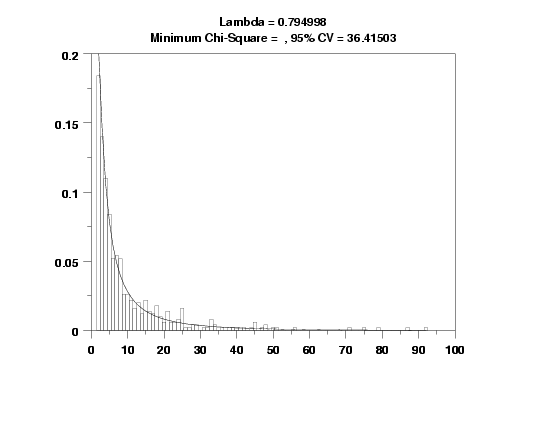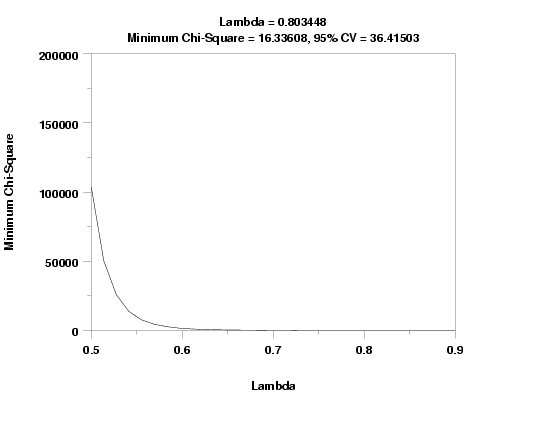

|
BTAPDFName:
 , and
k initial customers, the Borel-Tanner distribution is the
distribution of the total number of customers served before the
queue vanishes. , and
k initial customers, the Borel-Tanner distribution is the
distribution of the total number of customers served before the
queue vanishes.
The probability mass function of the Borel-Tanner distribution is

with The mean and variance of the Borel-Tanner distribution are

variance = 
<SUBSET/EXCEPT/FOR qualification> where <x> is a positive integer variable, number, or parameter; <lambda> is a number or parameter in the range (0,1) that specifies the first shape parameter; <k> is a number or parameter denoting a positive integer that specifies the first shape parameter; <y> is a variable or a parameter where the computed Borel-Tanner pdf value is stored; and where the <SUBSET/EXCEPT/FOR qualification> is optional.
LET Y = BTAPDF(X1,0.3,2) PLOT BTAPDF(X,0.3,2) FOR X = 2 1 20
LET K = <value> LET LAMBDA = <value> LET Y = BOREL-TANNER RANDOM NUMBERS FOR I = 1 1 N BOREL TANNER PROBABILITY PLOT Y BOREL TANNER PROBABILITY PLOT Y2 X2 BOREL TANNER PROBABILITY PLOT Y3 XLOW XHIGH To obtain the maximum likelihood estimate of lambda assuming that k is known, enter the command
BOREL TANNER MAXIMUM LIKELIHOOD Y2 X2 The maximum likelihood estimate is

with
For a given value of k, generate an estimate of
LET LAMBDA1 = <value> LET LAMBDA2 = <value> BOREL TANNER KS PLOT Y BOREL TANNER KS PLOT Y2 X2 BOREL TANNER KS PLOT Y3 XLOW XHIGH BOREL TANNER PPCC PLOT Y BOREL TANNER PPCC PLOT Y2 X2 BOREL TANNER PPCC PLOT Y3 XLOW XHIGH The default values of LAMBDA1 and LAMBDA2 are 0.05 and 0.95, respectively. The value of k should typically be set to the minimum value of the data. Due to the discrete nature of the percent point function for discrete distributions, the ppcc plot will not be smooth. For that reason, if there is sufficient sample size the KS PLOT (i.e., the minimum chi-square value) is typically preferred. Also, since the data is integer values, one of the binned forms is preferred for these commands. To generate a chi-square goodness of fit test, enter the commands
LET LAMBDA = <value> BOREL-TANNER CHI-SQUARE GOODNESS OF FIT Y2 X2 BOREL-TANNER CHI-SQUARE GOODNESS OF FIT Y3 XLOW XHIGH

 = =

 =
k =
k
the resulting distribution is referred to as the Lagrange-Poisson distribution (or the Consul generalized Poisson distribution). This distribution has probability mass function

Johnson, Kotz, and Kemp (1992), "Univariate Discrete Distributions", Second Edition, Wiley, pp. 394-396.
let k = 2
let lambda = 0.8
let y = borel tanner random numbers for i = 1 1 500
.
let y3 xlow xhigh = integer frequency table y
class lower 1.5
class width 1
let amax = maximum y
let amax2 = amax + 0.5
class upper amax2
let y2 x2 = binned y
.
let k = minimum y
borel tanner mle y
relative histogram y2 x2
limits freeze
pre-erase off
line color blue
plot btapdf(x,lambdaml,k) for x = 2 1 amax
limits
pre-erase on
line color black
let lambda = lambdaml
borel tanner chi-square goodness of fit y3 xlow xhigh
case asis
justification center
move 50 97
text Lambda = ^lambdaml
move 50 93
text Minimum Chi-Square = ^minks, 95% CV = ^cutupp95
.
let k = 2
label case asis
x1label Lambda
y1label Minimum Chi-Square
let lambda1 = 0.5
let lambda2 = 0.9
borel tanner ks plot y3 xlow xhigh
let lambda = shape
borel tanner chi-square goodness of fit y3 xlow xhigh
case asis
justification center
move 50 97
text Lambda = ^lambda
move 50 93
text Minimum Chi-Square = ^minks, 95% CV = ^cutupp95

CHI-SQUARED GOODNESS-OF-FIT TEST
NULL HYPOTHESIS H0: DISTRIBUTION FITS THE DATA
ALTERNATE HYPOTHESIS HA: DISTRIBUTION DOES NOT FIT THE DATA
DISTRIBUTION: BOREL-TANNER
SAMPLE:
NUMBER OF OBSERVATIONS = 500
NUMBER OF NON-EMPTY CELLS = 27
NUMBER OF PARAMETERS USED = 2
TEST:
CHI-SQUARED TEST STATISTIC = 17.10083
DEGREES OF FREEDOM = 24
CHI-SQUARED CDF VALUE = 0.155670
ALPHA LEVEL CUTOFF CONCLUSION
10% 33.19624 ACCEPT H0
5% 36.41503 ACCEPT H0
1% 42.97982 ACCEPT H0

CHI-SQUARED GOODNESS-OF-FIT TEST
NULL HYPOTHESIS H0: DISTRIBUTION FITS THE DATA
ALTERNATE HYPOTHESIS HA: DISTRIBUTION DOES NOT FIT THE DATA
DISTRIBUTION: BOREL-TANNER
SAMPLE:
NUMBER OF OBSERVATIONS = 500
NUMBER OF NON-EMPTY CELLS = 27
NUMBER OF PARAMETERS USED = 2
TEST:
CHI-SQUARED TEST STATISTIC = 16.33608
DEGREES OF FREEDOM = 24
CHI-SQUARED CDF VALUE = 0.124435
ALPHA LEVEL CUTOFF CONCLUSION
10% 33.19624 ACCEPT H0
5% 36.41503 ACCEPT H0
1% 42.97982 ACCEPT H0
Date created: 6/5/2006 |